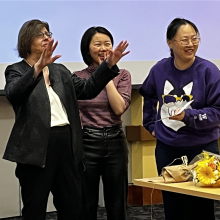Story Credit: Cricket Keating
On May 30th, 2024, after 48 years of teaching GWSS/PSYCH 357: Psychobiology of Women, Nancy Kenney walked into Kane Hall for her final class. She was greeted with a series of surprises: flowers from her colleagues, a collection of tribute messages from her students compiled by her TAs, and a sea of students dressed in purple to honor the occasion. It was a celebratory send-off and a fitting show of gratitude for all that Prof. Kenney had done over the years to build and shape the course.
Kenney was hired by the UW Gender, Women & Sexuality Studies (then Women Studies) and Psychology Departments in 1977, and she had first developed the Psychobiology of Women course as part of her job application. She remembers falling in love with the course as she put the syllabus together, explaining that “there were no books on the topic and so it was built totally from scratch. I knew I would teach the course in any department I ended up in. It remained my love ever since.”
Over the five decades since Kenney developed that first syllabus, the course has grown into an immensely popular cornerstone class for both departments. It focuses on topics of anatomy, physiology, and endocrinology, investigating how, in Kenney’s words, “they relate to major events of human lives from puberty to moods and emotions across the cycle to sexuality to contraception to unwanted pregnancy to pregnancy to menopause.” In the class, students have grappled with tough questions: What makes up a person’s sex? What are the major hormones of the reproductive system and how are they different or the same dependent on sex factors?
In her reflections on the course, Kenney has been struck by how much scientific knowledge and public awareness on these topics have shifted, as she puts it “Everything has changed!” There has been, in her opinion, an evolution towards complexity and multiplicity. For example, she notes, “In the beginning there was sex and it was divided into female and male and any intersex traits were anomalies/disease states. Now we understand that variation is the name of the game and force fitting of people into female and male categories is a social and cultural requirement and not fitting of biology.”
There has also been a greater recognition of how much there is left to learn, a recognition that required unsettling what were then accepted truths. For example, she shares, “then we KNEW that gender identity was a learned phenomenon. Now we have no idea what the underpinnings of gender identity are but it’s clear that there must be some foundational biological aspect.” Similarly, while there was an earlier assumption that “sexual preference was a behavioral choice,” currently research is pointing to evidence that “lesbians and straight women seem to have both genetic differences and differential exposure to reproductive hormones in utero,” though Kenney notes “there is still not a clear understanding” of these differences.
One of the other areas in which Kenney has seen a huge shift over the past 50 years has been in relation to the questions of menstruation and menopause. She observes that “In the mid-70s, you did not talk of menstruation except in whispers to close friends and female family members. Now menses and menopause are on the evening news!” In terms of medical treatment, she mentions there has been “whiplash on understanding the advantages and disadvantages of hormone-replacement after menopause.”
In reflecting on the thousands of students she has taught in the course, Kenney expresses that “students are so wonderful.” She has noticed shifts in students’ approaches to the course over the years as well, sharing that “in the early days I could tell the GWSS studies students from the Psych students by their behavior in class. Psych students took notes. GWSS students raised their hands and said, ‘how can you say that?’ Not true anymore. All students have become more engaged, more questioning.” One of the hardest questions the students asked her was to define the word woman. Trying to answer that question, Kenney recalls, “took me 6 pages of single-spaced typing to consider and reject all the ideas of what was required to define a person as a woman.”
Because of its subject matter, the course attracts students who “have avoided science as much as they could” and are thus “tricked into learning serious biological science to understand their body.” For Kenney, the most rewarding moments of teaching Psychobiology of Women have been seeing how important this learning has been for them. In her words, “It’s the women (age 60 or higher) who say, ‘I’ve been through it all and never knew why.’ It’s the guy who did as little as he could to pass the course who, 20 years later, writes to say how useful the course was in raising his 4 daughters. It’s the women who can talk about their physical conditions and understand the language of their physicians.”
Kenney feels she was “truly blessed by my last group of students” at UW this past spring. Knowing that she would retire at the end of the quarter, she told them that “this was my last class and I really needed them to make the experience great. I needed them to care about the material and ask questions.” And they did it. “I was asked at least 5 questions that had NEVER been asked before. That’s really hard after more than 12,000 students.”
Addendum: Thanks to Dr. Kenney’s advocacy, GWSS 357 will not retire with her. Teaching Professor Ann Culligan will take up the mantle, and Psychobiology of Women will next be offered in Spring 2025.
Further reading: See Chaitna Deshmukh’s article “Psychobiology of Women: Relic or Relevant?” published in The Daily on April 25, 2024. Answer: Relevant!
